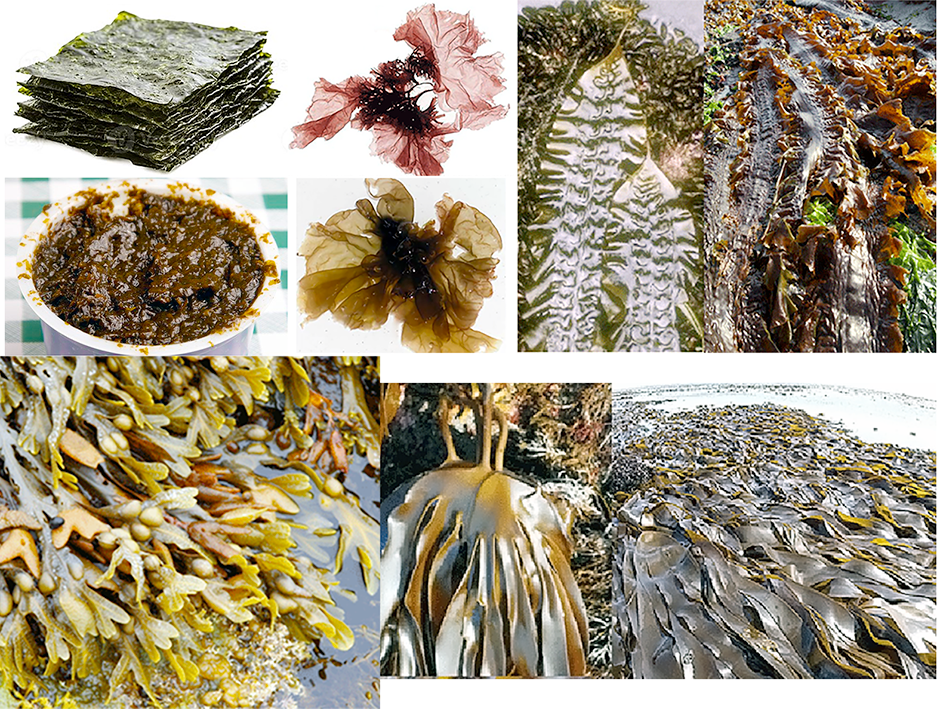FabulousFusionFood's Seaweed-based Recipes 2nd Page
 Examples of edible seaweed (clockwise from top left): dried nori and Welsh laverbread,
Examples of edible seaweed (clockwise from top left): dried nori and Welsh laverbread,purple and brown laver, sugar kelp, oarweed, bladderwrack.
Welcome to FabulousFusionFood's Seaweed-based Recipes Page —Seaweed, or macroalgae, refers to thousands of species of macroscopic, multicellular, marine algae. The term includes some types of Rhodophyta (red), Phaeophyta (brown) and Chlorophyta (green) macroalgae. Seaweed species such as kelps provide essential nursery habitat for fisheries and other marine species and thus protect food sources; other species, such as planktonic algae, play a vital role in capturing carbon and producing at least 50% of Earth's oxygen.
Humans have a long history of cultivating seaweeds for their uses. In recent years, seaweed farming has become a global agricultural practice, providing food, source material for various chemical uses (such as carrageenan), cattle feed and fertilizers. Due to their importance in marine ecologies and for absorbing carbon dioxide, recent attention has been on cultivating seaweeds as a potential climate change mitigation strategy for biosequestration of carbon dioxide, alongside other benefits like nutrient pollution reduction, increased habitat for coastal aquatic species, and reducing local ocean acidification. The IPCC Special Report on the Ocean and Cryosphere in a Changing Climate recommends "further research attention" as a mitigation tactic.
"Seaweed" lacks a formal definition, but seaweed generally lives in the ocean and is visible to the naked eye. The term refers to both flowering plants submerged in the ocean, like eelgrass, as well as larger marine algae. Generally, it is one of several groups of multicellular algae; red, green and brown. They lack one common multicellular ancestor, forming a polyphyletic group. In addition, blue-green algae (Cyanobacteria) are occasionally considered in seaweed literature. The number of seaweed species is still a topic of discussion among scientists, but it is most likely that there are several thousand species of seaweed.
Seaweed farming or kelp farming is the practice of cultivating and harvesting seaweed. In its simplest form farmers gather from natural beds, while at the other extreme farmers fully control the crop's life cycle. The seven most cultivated taxa are Eucheuma spp., Kappaphycus alvarezii, Gracilaria spp., Saccharina japonica, Undaria pinnatifida, Pyropia spp., and Sargassum fusiforme. Eucheuma and K. alvarezii are attractive for carrageenan (a gelling agent); Gracilaria is farmed for agar; the rest are eaten after limited processing. Seaweeds are different from mangroves and seagrasses, as they are photosynthetic algal organisms and are non-flowering.
Seaweed is also commonly foraged from shoreline and shore cliff sites. The most commonly foraged and consumed seaweed in the UK and Ireland are described in this site's guide to edible seaweed.
Seaweed is consumed across the world, particularly in East Asia, e.g., Japan, China, Korea, Taiwan and Southeast Asia, e.g. Brunei, Singapore, Thailand, Burma, Cambodia, Vietnam, Indonesia, the Philippines, and Malaysia, as well as in South Africa, Belize, Peru, Chile, the Canadian Maritimes, Scandinavia, South West England, Ireland, Wales, Hawaii and California, and Scotland.
Gim (김, Korea), nori (海苔, Japan) and zicai (紫菜, China) are sheets of dried Porphyra used in soups, sushi or onigiri (rice balls). Gamet in the Philippines, from dried Pyropia, is also used as a flavouring ingredient for soups, salads and omelettes. Chondrus crispus ('Irish moss' or carrageenan moss) is used in food additives, along with Kappaphycus and Gigartinoid seaweed. Porphyra is used in Wales to make laverbread [bara lafwr, cy] (sometimes with oat flour). In northern Belize, seaweed is mixed with milk, nutmeg, cinnamon and vanilla to make "dulce" ("sweet").
Alginate, agar and carrageenan are gelatinous seaweed products collectively known as hydrocolloids or phycocolloids. Hydrocolloids are food additives. The food industry exploits their gelling, water-retention, emulsifying and other physical properties. Agar is used in foods such as confectionery, meat and poultry products, desserts and beverages and moulded foods. Carrageenan is used in salad dressings and sauces, dietetic foods, and as a preservative in meat and fish, dairy items and baked goods.
Not only are seaweed foraged, they are now also becoming increasingly commercially available, from dried seaweed like Japanese nori available in sheets to powdered bladderwrack used as health supplements. They are also sold as seasoning blends like French Quatre Algues or Seaweed Salt sold as a low-sodium alternative to ordinary table or sea salt.
The alphabetical list of all the seaweed-based recipes on this site follows, (limited to 100 recipes per page). There are 110 recipes in total:
Page 2 of 2
| Smoked Salmon and Avocado Nori Rolls Origin: Japan | Terrine de Congue aux Algues (Conger Terrine with Seaweed) Origin: France | Tortas de Ervas do Alhau (Fried Gutweed Corvo Style) Origin: Portugal |
| Spam Musubi Origin: Hawaii | Terrine de la mer (Seafood terrine) Origin: France | Winter Mushroom and Smoked Fish Soup Origin: Fusion |
| Swffle Bara Lawr (Laverbread Soufflé) Origin: Welsh | Terrine de saumoun aux Quatre algues (Terrine of Salmon with Quatre Algues) Origin: France | |
| Tagliarini with Gurnard, Parsley, Garlic and Sea Spaghetti Origin: England | Tofu Laver and Leek Croquettes Origin: Ireland |
Page 2 of 2